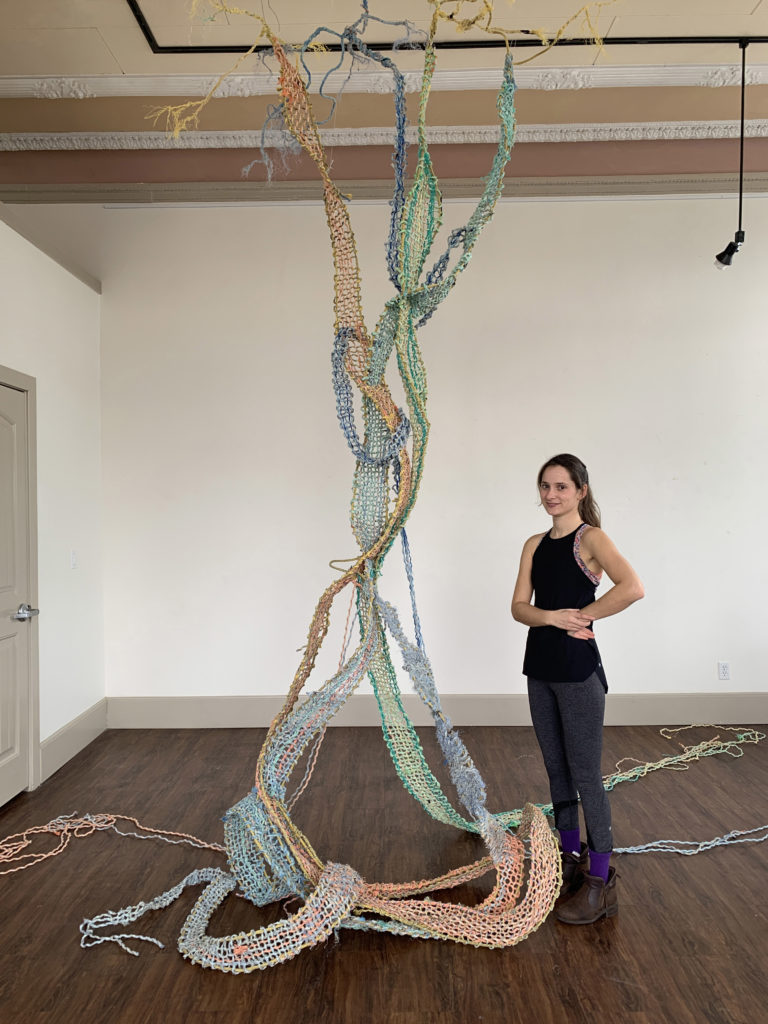OXNARD — Emma Akmakdjian’s Anthropocene Kelp Forest is now on exhibit through Aug. 26 at Channel Islands Maritime Museum.
Akmakdjian’s mixed media artworks trace the troubled relationship of human and environment through material byproducts of industrial processes. Born and raised in Southern California, her early passion as a tidal pool observer led her to create art inspired by the ecological changes she witnessed in urban water runoff. Emma creates art in conversation with scientists and members of diverse community groups, such as botanists of the Hualapai Indian Tribe. Her woven sculptures combine ancestral weaving practices with found industrial materials such as nylon commercial fishing rope. Emma’s sculptures consider the symbiotic influence of society and nature. The interconnected web of life is made apparent through repurposing material run-off; pollution, plastics, and overfishing debris returned from the Living Ocean. Observations and data collections of coastal populations, development, plastics, global ocean economies, and native cultures are visualized through her art. Emma received her Bachelor of Arts from California State University Channel Islands and studied at both CSU (California State University) Florence, and L’Accademia di Belle Arti in Florence, Italy.
Anthropocene Kelp Forest
 The inspiration for Anthropocene Kelp Forest comes from conversations I have had with marine scientists regarding the preservation of marine environments encompassing the California Channel Islands. Off the coasts of these Islands are richly biodiverse ecosystems of (Macrocystis pyrifera) sea kelp. Unregulated oceans, overfishing, and lack of Marine Protected Areas are resulting in the depletion of these once abundant kelp forests that foster a vast array of marine species. Through weaving processes applied to salvaged nylon fishing ropes, I illustrate their complex intricacies. The Anthropocene Kelp Forest investigates how the ocean is connected to ancestral navigation, human settlement, and global colonization. My choice to weave kelp sculptures is inspired by the traditional weaving practices of Chumash ancestors that lived on Santa Rosa Island for thousands of years before colonial secularization. I feel an innate connection to the meditative and meticulous method of loosely arranging cords of synthetic nylon fishing rope. The materiality of the rough, rigid, and fraying plastic rope has heightened my confliction with Ocean pollution and given me a passion for communicating environmental concern.
The inspiration for Anthropocene Kelp Forest comes from conversations I have had with marine scientists regarding the preservation of marine environments encompassing the California Channel Islands. Off the coasts of these Islands are richly biodiverse ecosystems of (Macrocystis pyrifera) sea kelp. Unregulated oceans, overfishing, and lack of Marine Protected Areas are resulting in the depletion of these once abundant kelp forests that foster a vast array of marine species. Through weaving processes applied to salvaged nylon fishing ropes, I illustrate their complex intricacies. The Anthropocene Kelp Forest investigates how the ocean is connected to ancestral navigation, human settlement, and global colonization. My choice to weave kelp sculptures is inspired by the traditional weaving practices of Chumash ancestors that lived on Santa Rosa Island for thousands of years before colonial secularization. I feel an innate connection to the meditative and meticulous method of loosely arranging cords of synthetic nylon fishing rope. The materiality of the rough, rigid, and fraying plastic rope has heightened my confliction with Ocean pollution and given me a passion for communicating environmental concern.

